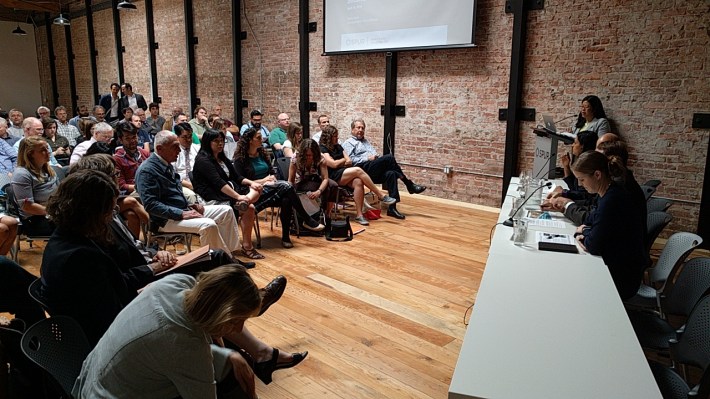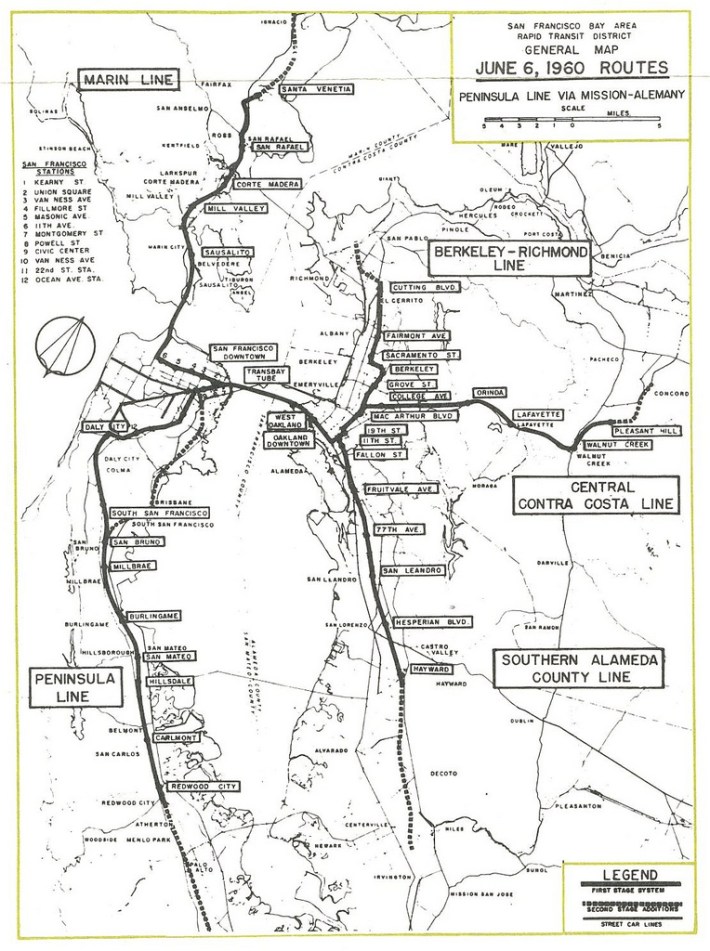The San Francisco Bay Area Planning and Urban Research Association (SPUR) sponsored a meeting Wednesday afternoon in their Oakland office to discuss the need for a new Transbay crossing. Some 60 people attended the panel discussion, which lasted roughly two hours and looked at all imaginable challenges to developing, funding and building a second rail crossing from San Francisco to Oakland.
"This conversation has been going on for a very long time; often it's been in the domain of hobbyists and advocates," said Ratna Amin, Transportation Policy Director for SPUR. "Now is the time to move the idea of a second BART tube into the realm of a real project." Amin presented background, with a map of the original vision for BART, which was to go to Marin as well. Then, as now, BART "was a really visionary response to growth in automobiles and congestion getting worse in the future," she explained.
One theme that came out of the conference, was that when they talk about BART, they aren't necessarily talking about BART's non-standard gauge and equipment. "We're not looking at anything as a stand alone project. It's a statewide project," added Amin. By that she means that High Speed Rail, Caltrain, Amtrak, ACE and all regional rail systems that use standard gauge tracks need to be able to use the new tube. "A new tube—it is either standard gauge or it is both."
The conference comes after a white paper from SPUR about what a second BART tube might look like and where it could run. But the conference dug deeper into some of the pragmatic questions, such as how to make sure such a large project doesn't suffer the same cost overruns and embarrassments of the new eastern span of the Bay Bridge.

"Bad news: if you look at mega-projects across the globe, 98 percent are either above cost or behind schedule," said Shannon Peloquin, an associate partner at the management consultancy McKinsey & Company. "Average time slippage is 20 months."
With that kind of a record globally, what hope would a $10 billion Transbay tube project have not to run over budget and behind schedule? Peloquin gave a number of suggestions, among them making sure the project is administered by a distinct agency whose only task is to get it done on time and on budget.
How is this going to get paid for? The state, according to Kate White, Deputy Secretary for Environmental Policy and Housing Coordination at the California State Transportation Agency said the tube "absolutely needs to be a centerpiece of the state rail plan... we do have significant cap and trade dollars going to transit and rail from the state." Of course, exactly how much that would be and getting the legislature to actually allocate cap and trade funds for a BART tube (or anything else) can be tricky.
The conference made it clear, however, that the economic need is there--that is, if the Bay Area wants to continue growing. "25 percent of all trips in the Bay Area are by BART, and half of those are through the tube," said Sean Randolph, Senior Director of the Bay Area Council Economic Institute, adding that the system is already strained beyond capacity, which means that any delay causes a ripple effect. "Service interruptions have grown by 26 percent. Any kind of police activity or a health problem with a passenger--with one tube, the whole thing just stops."
The panelist also discussed how drilling technology has improved and, in all likelihood, a new tube would be bore tunneled, rather than dropped into the Bay like the current tube was built in the 1970s. That said, Ellen Smith, Manager of Strategic and Policy Planning for BART, pointed out that they also are working on short term solutions. For example, by offering discounts for people to take a later train, peak loads can be thinned. "We just want to get some people to wait 20 minutes," she explained, which can relieve some strain when ridership is at its maximum.
Echoed throughout the conference: this isn't a question of "if" the area needs a second crossing. It's a question of how to build it. "At some point the first tube will need rehabilitated or even replaced, so we need a second tube. We need a second tube," said Smith.







